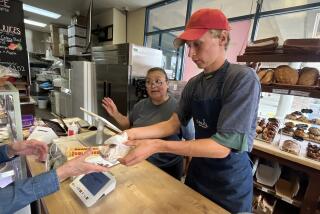Shaft Is Site of Quake Sensors : Lode of Temblor Data Being Sought at Old Mine
- Share via
SAN JOSE — Muddy Creek Mine never yielded much gold before it was abandoned more than 100 years ago, but scientists say it may provide precious nuggets of information as the new site of high-tech earthquake sensors that are part of a $2-million worldwide network.
Stooping low past the entrance to the mine in Chualar Canyon, the scientists installed three tiny seismometers in bell jars and a digital recorder that will enable them to gather the most accurate details on earthquakes available for analysis by computer.
The sensors are part of the Geoscope Project, a network of 25 seismological stations sponsored by France’s National Science Institute that will encircle the globe with devices on every continent.
In the United States, the only stations will be the one here, run by the Charles F. Richter Seismological Laboratory at the University of California, Santa Cruz, another in Boston run by the Massachusetts Institute of Technology and a third in Hawaii.
“We’ll be able to detect disturbances and measure earthquakes and the ringing of the earth after quakes with accuracy that’s never been achieved,” said Richter Lab Director Karen C. McNally.
“Almost all magnitude 5 quakes anywhere in the world can be recorded with this network,” she said. “It’s extremely sensitive and has what we call a wide dynamic range and very broad band. That means from magnitude 5 to magnitude 9 it will still be on scale, and it can record all the little wavelets, from one-10th of a second to 400 seconds long.”
Richter’s work in the 1930s led to the scale that bears his name. The scale is a gauge of energy released by an earthquake, as measured by the ground motion recorded on a seismograph or seismometer.
The three seismometers in the mine measure three-dimensional motion--two horizontal and one vertical--and are so sensitive that great care had to be placed in finding a spot for them.
“We looked for two full years to find the perfect spot because the instrument is so sensitive to all kinds of things, such as little wind disturbances, waves crashing against the shore and the running of deer,” McNally said.
Muddy Creek Mine is about 80 miles southeast of the Santa Cruz campus and about 20 miles from the ocean. More than 100 years ago, it was in an area of great activity as the Chinese, who came to work on the railroad, looked for gold nearby.
“There never was much gold found there, just a minimal amount,” said Naomi Johnson Gillott, a descendant of the Johnson family that bought the mine as part of a 10,000-acre cattle ranch that they operated.
Gillott, 50, said she is pleased to give the university a long-term lease to operate the station because she grew up hearing so many tales from relatives of the Great Quake of 1906 that destroyed much of San Francisco.
Coincidentally, the University of Nevada chose the Muddy Creek Mine to place a seismometer about 10 years ago, McNally said. She said the Santa Cruz researchers decided on the same mine without knowing about the previous seismometer there.
“If the scientists get some figures that would help them learn more about earthquakes, I’ll feel good about being part of it,” Gillott said.
The intricate, Swiss-made seismometers, each about six inches tall, sit inside jars on top of a steel plate. The plate has been set on a concrete pier coupled to bedrock eight feet behind locked doors inside the Muddy Creek Mine and near the bottom level about eight feet deep.
Shields have been placed above the bell jars, and the whole unit is about the size of a large grocery cart.
The measurements of the seismometers will be recorded digitally at the mine and relayed automatically by telephone to a computer at the Richter Lab.
Similar devices have been set up or are planned at the South Pole and in Japan, northern China, Algeria, Senegal, Tahiti, French Guyana, New Caledonia, France, Djibouti, Australia, Costa Rica and Brazil, as will as other sites.
“We will be concentrating on quakes in California and in Latin America,” McNally said. “We should have no difficulty recording magnitude 3 up and down the coast from Baja California to the northern part of the state. We’d be getting up to magnitude 4 with accuracy in Mexico City and up around the Canada border. In South America, we’ll be accurate at around 4.5.”
Measurements will be coordinated with other seismometers to pinpoint the location and magnitude of quakes.
More to Read
Sign up for Essential California
The most important California stories and recommendations in your inbox every morning.
You may occasionally receive promotional content from the Los Angeles Times.













